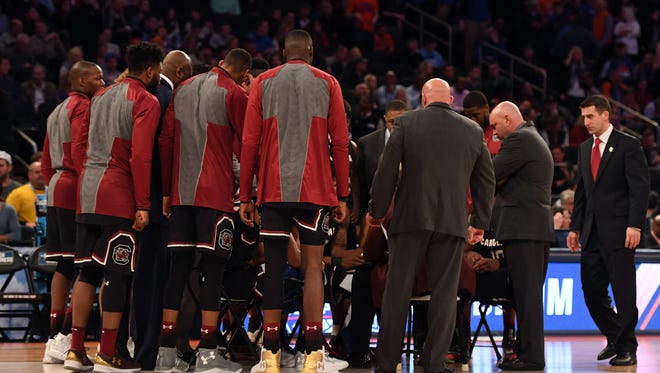Hidden heroes of March Madness step up during timeouts
NEW YORK — The moment the television cameras cut away, the real work begins.

As a national TV audience is treated to yet another commercial, three South Carolina staffers begin the high-wire choreography of seating, hydrating and preparing the Gamecocks for the next four-plus minutes of game action.
It seems like a simple enough task for strength and conditioning coach Scott Greenawalt, director of basketball operations Andy Assaley and director of student-athlete development Doug Edwards: Grab the stools stamped with the Gamecocks logo from behind the bench and sprint onto the court to set them up for fiery head coach Frank Martin and also the five players currently in the game to sit on during the timeout.
Yet the stakes can be high.
March Madness: Four bold projections for the Final Four
Unexpected Final Four features favored North Carolina and three tough outs
Final Four: North Carolina gets to act like it has been there before
Add Luke Maye's name to the list of March Madness heroes
“The No. 1 goal is not to get yelled at,” Greenawalt says. “You’ve got to be efficient. Don’t let him wait for a stool or a grease board.”
It’s a dance that plays out eight times every game — during the media-mandated timeouts that come at the first whistle after the 16-, 12-, 8- and 4-minute marks of each half.
But the conditions are even more compact during the Big Dance.
During the regular season, student managers are in charge of stools, water bottles, towels — anything and everything the team might need during an in-game break. But in an NCAA tournament setting where so much is regimented and uniform, there are fewer seats along each team’s bench. That means managers get relegated to seats in the stands or elsewhere too far away from the bench to perform these traditional duties.
Most notably: The deployment of each team’s stools, which, in addition to functionality, offer comfort and a little piece of home amid so much tournament uniformity.
Each NCAA tournament team fills its manager void differently. Some use seldom-used bench players; others rely on assistant coaches. Martin, for example, assigned the same three staff members who had this duty when he last coached in the NCAA tournament — at Kansas State — to be responsible for the stools during this year’s run, too.
Once they got their assignment after Selection Sunday, they were worried they’d be rusty.
“We talked about it for a few days, trying to make sure we were sharp,” Assaley says. “We had to figure out who’s going to take care of what.”
Though there were nerves, there was no dress rehearsal. But as the clock neared the 16-minute mark of South Carolina’s first tournament game, against Marquette, the pressure was palpable.
Especially for Greenawalt, who is responsible for Martin’s chair, the board and markers to go along with it.
Wisconsin redshirt junior walk-on Aaron Moesch knows that feeling. During the Badgers’ run to the Sweet 16, he was responsible for one player stool and head coach Greg Gard’s stool.
“With Coach’s stool, it’s scary,” says Moesch, a 6-8 forward. “If you don’t put it down and he falls, you’ll probably get kicked off the team or whatnot.”
Moesch has had this duty before, he said, in previous NCAA tournaments, so he’s used to it. But despite coming oh-so-close to living out a dream during Wisconsin’s first-round game against Virginia Tech, he hasn’t been able to set out a stool for himself.
March Madness: Four burning questions for the Final Four
The 10 schools with the best combined basketball and football seasons
Who stays, who goes for UK basketball?
“I had the thought, around the four-minute media timeout mark, if I went in at four minutes and five seconds, or something, to give Nigel (Hayes) a break, which I’ve done before,” Moesch says. “If the whistle blows, I would have to run off the court, go behind the bench, grab the stools and put one down for myself and then coach and then sit down. I thought that would be really funny, and I hoped it would happen.”
Alas. He just missed the opportunity of a lifetime. But there’s always next year, another stool and perhaps a more fortuitous subbing pattern.
Xavier also put players in charge of its stools during its run to the Elite Eight, though head coach Chris Mack has a stricter system than most in regards to the ordering of the seats. He wants his point guard sitting directly across from him, with the 2 and 4 seated to Mack’s right, and the 3 and 5 to his left.
“That's how he likes it done,” junior Sean O’Mara says. “It makes organization simple as far as knowing who's in the game when you've got 15 guys huddling around you all in the same jersey. If you're in this spot, you're in. If you're not, you're out. It's pretty dictated but I know why he does it, and I think it works.”

Florida’s system is somewhat similar. Head coach Mike White insists that the backups stand directly behind the player who plays his same position.
“If he’s talking to the point guard, the backup point guard better be paying attention,” says Florida strength and conditioning coordinator Preston Greene, who was responsible for three chairs during the Gators’ tournament run. “That way it’s organized and it flows.”
That doesn’t mean there isn’t stress, and pseudo-war stories, from those who are fortunate enough to be part of NCAA tournament runs but unfortunate enough to land the extra assignment.
“In 2014 at the Final Four, I had to do four chairs,” Greene says. “I was double-fisting and running like a maniac, throwing them down as fast as possible.”
He laughs.
“But it worked, somehow, in terms of spacing and creating a nice little semicircle,” he says.
Contributing: Dan Wolken in San Jose.
MEET THE FINAL FOUR TEAMS
